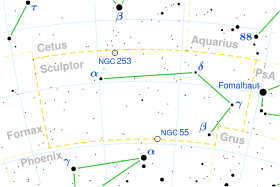Zeta Sculptoris
Zeta Sculptoris, Latinized from ζ Sculptoris, is a multiple star system in the constellation Sculptor. It is faintly visible to the naked eye with an apparent magnitude of 5.04.[2] The annual parallax shift is 6.49 mas, which yields a distance estimate of about 500 light years from the Sun. It is moving further away with a radial velocity of +8.6 km/s.[5] Zeta Sculptoris is near the Blanco 1 cluster as viewed from Earth, although parallax measurements indicate it to be substantially closer.[6]
| Observation data Epoch J2000 Equinox J2000 | |
|---|---|
| Constellation | Sculptor |
| Right ascension | 00h 02m 19.92035s[1] |
| Declination | −29° 43′ 13.4873″[1] |
| Apparent magnitude (V) | 5.04[2] |
| Characteristics | |
| Spectral type | B5 V[3] |
| U−B color index | -0.55[4] |
| B−V color index | -0.16[4] |
| Astrometry | |
| Radial velocity (Rv) | +8.6±1.6[5] km/s |
| Proper motion (μ) | RA: +9.34[1] mas/yr Dec.: +14.50[1] mas/yr |
| Parallax (π) | 6.49 ± 0.25[1] mas |
| Distance | 500 ± 20 ly (154 ± 6 pc) |
| Absolute magnitude (MV) | −0.89[2] |
| Orbit[6] | |
| Period (P) | 1,740±22 d |
| Eccentricity (e) | 0.316±0.043 |
| Periastron epoch (T) | 2453381 ± 37 JD |
| Argument of periastron (ω) (secondary) | 43.5±6.9° |
| Semi-amplitude (K1) (primary) | 12.4±0.6 km/s |
| Details | |
| Mass | 5.5[7] M☉ |
| Luminosity | 496[2] L☉ |
| Temperature | 16,100[3] K |
| Metallicity [Fe/H] | 0.00[8] dex |
| Rotational velocity (v sin i) | 15[9] km/s |
| Other designations | |
| Database references | |
| SIMBAD | data |
The primary component, designated Zeta Sculptoris A, is a single-lined, low amplitude spectroscopic binary system with an orbital period of 4.8 years and an eccentricity of 0.32.[6] The visible member of this pair is a B-type main-sequence star with a stellar classification of B5 V.[3] It has a 13th magnitude companion, Zeta Sculptoris B, at an angular separation of 3 arcseconds along a position angle of 330° (as of 1927).[10] According to Eggleton and Tokovinin (2008), it is most likely gravitationally bound to the primary component.[11]
References
- Van Leeuwen, F. (2007). "Validation of the new Hipparcos reduction". Astronomy and Astrophysics. 474 (2): 653. arXiv:0708.1752. Bibcode:2007A&A...474..653V. doi:10.1051/0004-6361:20078357. Vizier catalog entry
- Anderson, E.; Francis, Ch. (2012). "XHIP: An extended hipparcos compilation". Astronomy Letters. 38 (5): 331. arXiv:1108.4971. Bibcode:2012AstL...38..331A. doi:10.1134/S1063773712050015. Vizier catalog entry
- Zorec, J.; Cidale, L.; Arias, M. L.; Frémat, Y.; Muratore, M. F.; Torres, A. F.; Martayan, C. (2009). "Fundamental parameters of B supergiants from the BCD system". Astronomy and Astrophysics. 501: 297. arXiv:0903.5134. Bibcode:2009A&A...501..297Z. doi:10.1051/0004-6361/200811147.
- Mallama, A. (2014). "Sloan Magnitudes for the Brightest Stars". The Journal of the American Association of Variable Star Observers. 42: 443. Bibcode:2014JAVSO..42..443M.Vizier catalog entry
- Gontcharov, G. A. (2006). "Pulkovo Compilation of Radial Velocities for 35 495 Hipparcos stars in a common system". Astronomy Letters. 32 (11): 759. arXiv:1606.08053. Bibcode:2006AstL...32..759G. doi:10.1134/S1063773706110065.
- González, J. F.; Levato, H. (November 2009), "Spectroscopic study of the open cluster Blanco 1", Astronomy and Astrophysics, 507 (1): 541–547, Bibcode:2009A&A...507..541G, doi:10.1051/0004-6361/200912772
- Tetzlaff, N.; Neuhäuser, R.; Hohle, M. M. (2011). "A catalogue of young runaway Hipparcos stars within 3 kpc from the Sun". Monthly Notices of the Royal Astronomical Society. 410: 190. arXiv:1007.4883. Bibcode:2011MNRAS.410..190T. doi:10.1111/j.1365-2966.2010.17434.x. Vizier catalog entry
- Gontcharov, G. A. (2012). "Dependence of kinematics on the age of stars in the solar neighborhood". Astronomy Letters. 38 (12): 771. arXiv:1606.08814. Bibcode:2012AstL...38..771G. doi:10.1134/S1063773712120031. Vizier catalog entry
- Abt, Helmut A.; Levato, Hugo; Grosso, Monica (2002). "Rotational Velocities of B Stars". The Astrophysical Journal. 573: 359. Bibcode:2002ApJ...573..359A. doi:10.1086/340590.
- Mason, Brian D.; Wycoff, Gary L.; Hartkopf, William I.; Douglass, Geoffrey G.; Worley, Charles E. (2001). "The 2001 US Naval Observatory Double Star CD-ROM. I. The Washington Double Star Catalog". The Astronomical Journal. 122 (6): 3466. Bibcode:2001AJ....122.3466M. doi:10.1086/323920. Vizier catalog entry
- Eggleton, P. P.; Tokovinin, A. A. (2008). "A catalogue of multiplicity among bright stellar systems". Monthly Notices of the Royal Astronomical Society. 389 (2): 869. arXiv:0806.2878. Bibcode:2008MNRAS.389..869E. doi:10.1111/j.1365-2966.2008.13596.x.
